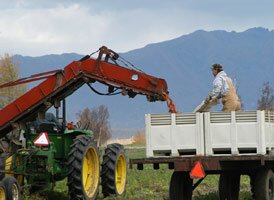On The Farm
It was the curiosity of Alaska that brought the VanderWeele family to Alaska, but it was Alaska soil that kept them here.
Why does a man and his wife from the Netherlands choose to immigrate to Alaska? Simple, a young farmer needs wide-open spaces and fertile land in order to grow. Ben VanderWeele and his wife, Suus, came to Alaska to begin their farming business in 1967 because farmland in the Netherlands was not widely available. Farming must be in their blood, as the VanderWeele's parents were farmers in the Netherlands and all of their children have come back to farming as well.
Today, VanderWeele runs the 160-acre VanderWeele Farms with the help of his three children and 25 to 30 seasonal employees. The variety of crops is diverse, with most of his farm yielding potatoes, lettuce, cabbage, zucchini, radishes and onions. The VanderWeeles have their own trucks that they use to deliver their produce to wholesale customers such as Carrs/Safeway, Fred Meyer and the NANA Native Corporation.
 Everyone in the Valley agrees that Alaska is a great place to farm because of the cooler temperatures. VanderWeele said this is because the climate reduces the amount of pesticides necessary, there is less disease, and the land is cleaner overall. With these benefits, the VanderWeele Farms are able to emphasize the care "that grows into VanderWeele crops."
Everyone in the Valley agrees that Alaska is a great place to farm because of the cooler temperatures. VanderWeele said this is because the climate reduces the amount of pesticides necessary, there is less disease, and the land is cleaner overall. With these benefits, the VanderWeele Farms are able to emphasize the care "that grows into VanderWeele crops."
VanderWeele has been a part of the Alaska Grown Program since the beginning in 1986. The sense of Alaska pride and freshness of the products is why the VanderWeeles have been supporting the Alaska Grown program for so long. VanderWeele Farms would like to see more support from local wholesalers, but regardless, he says it is very "satisfying to grow crops for fellow humans."
http://www.alaskagrown.org/shopEat/onFarm/index.html
Slightly less than half of Alaskans live in the Greater Anchorage–Kenai Peninsula area. This region is known for its milder temperatures, proximity to the sea, ice-free ports, and petroleum and natural gas development. It is also the centre of air, road, and rail transportation and the headquarters of Alaska’s major banks, corporations, and federal and state administrative agencies.
Settlement patterns
About one-seventh of the population lives in the Greater Fairbanks area, including the town of Delta Junction, historically the centre of gold mining and the terminus of the Alaska Railroad, which runs from Seward to Fairbanks. The larger cities of the south coastal archipelago and the Gulf of Alaska islands—Ketchikan, Petersburg, Sitka, and Juneau—and surrounding areas collectively contain about one-fourth of Alaska’s population and are fishing and tourism centres.
About one-fifth of Alaskans live in small communities situated along rivers, highways, or the coast. Many of these are in Arctic and western Alaska, where the major settlements include Barrow (at Point Barrow), Kotzebue, Nome, Bethel, Dillingham, Kodiak, and Unalaska—all of which experienced significant population growth in the last quarter of the 20th century. Barrow is the major hub of the North Slope as well as the northernmost town in the United States, and it has derived significant tax revenues from Prudhoe Bay oil.
State calls for village wind farms
In the coastal tundra village of Kongiganak, some residents are keeping their lights on this winter by promising to sign over future tax refunds.But the persistent Bering Sea winds that drive up the cost of light and heat in impoverished Western Alaska are now bringing a promise of redemption as well.
Last week the state proposed spending $14 million to erect wind farms in six villages on the Yukon-Kuskokwim Delta, including Kongiganak. It's part of a plan for spending $100 million on renewable energy around Alaska to reduce consumption of expensive diesel fuel and bring down local electric bills.
"The wind turbine is a blessing for us," Harvey Paul, general manager of the local power company, Puvurnaq, said Monday. "We have some of the highest fuel prices in the state and some of the best winds."
No longer will seal hunters have to complain when rough weather keeps their skiffs on the beach, Paul said. "Now they'll stay home and enjoy the wind and be happy that their electric rates are going down."
The problems in rural Alaska posed by high energy costs and a poor fishing season swept into the news this month with dramatic reports from Emmonak and nearby villages on the Yukon delta. Some critics accused the state of being slow to respond to a humanitarian crisis.
But last year, with oil prices soaring, the Legislature did take aim at the long-term with the Renewable Energy Fund. Lawmakers committed $50 million for the first year, then added another $50 million during a special session on energy.
The six delta wind projects are on a list of 72 renewable energy priorities recommended by the Alaska Energy Authority last week. The list also includes wind projects around Nome and Kotzebue, wood-burning boilers in the Interior, small hydro feasibility studies and help for Railbelt utilities.
The priority recommendations must be approved in the next few weeks by the Legislature, which must also decide whether to continue funding the program at a recommended pace of $50 million a year.
http://www.adn.com/news/alaska/rural/story/668494.html
